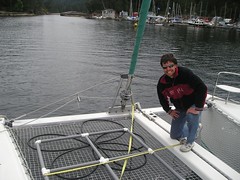We passed a semi-insignificant milestone this week -- we’ve officially been “cruising” for one month. The girls remarked on the anniversary at dinner last night. We shared a familial moment of “huh?” as we contemplated the impossible notion that we had only been out and about for a single month. The consensus reached was that we had been cruising since roughly the dawn of time. Proof was found in the smell of Mera and Aeron’s cabin, and the fact that we had already run out of peanut butter.
The purpose of this summer’s cruising has always been to “break stuff and learn a lot” while still in relatively familiar territory. You’ll be happy to know that Dr C and I are succeeding admirably. A short, incomplete list of what we’ve broken includes: the alternator, the chart plotter, the jib furler, the camera, the starboard head, the sail cover, the hinges on the cabinet door under the sink, the pencil sharpener, the oven solenoid, the wind direction indicator, the forestay, starboard hatch latch #2, Dr C’s back, the port jib line, all of my nails, and the broom. With the exception of my nails and the B&G electronic wind indicator, to date we’ve fixed everything we’ve broken.
What we’ve learned would fill a cruising book. Depressingly, what we’ve learned actually does fill a cruising book. I suspect now that reading all those tomes was a serious waste of time. It didn’t just go in one ear and out the other. The information apparently went whistling through our heads stripping brain cells like a pin ball run amuck in the machinery of our cruising expectations. Had we read nothing whatsoever, we would at least have gone out scared spitless. We probably should be scared spitless. We’re really bad at this.
Here’s the problem. Fundamentally, the cruising life involves a rather short list of repetitive behaviors that are so deeply steeped into the very fiber, fabric and essence of your soul that you replicate them each and every time. Unfortunately, Dr C and I have all the memory retention capacity of a terrier on anti-depressant doggy dopers.
Let’s take, for example, leaving an anchorage. It shouldn’t be hard. Engines on, pull up anchor, drive off. Not so fast! Did you fly the dinghy on the davits? Release the boom swing preventer? Shut the salon windows so the jib sheets don’t rip them off? Bring in all the blue clothes and towels from the lifelines? Stow the inflatable alligator in the forward locker? Is the swim ladder up? The dinghy painter carefully stowed so it can’t tangle the props? The nav and autopilot instruments turned on? Do you have Mera?
Before pulling anchor, you also need to know where you’re going, check charts, weather, and cruising guide then plan a route and program it into the nav station. Woo, there skipper. You forgot to check the tide tables and the current tables. It wouldn’t hurt to stow the computers, get the kids settled for school, and put on some decent music as well. If this is going to be a long slog, make sure you get your socks on, grab the iPod and a book of Sudoku, and throw some sewing supplies on the helm so there’s something to do. If you fail to do even one of these tasks, something bad will happen. The highest probability is that something will involve breaking something expensive.
I can’t remember all that crap. I can barely remember how to count to 10 in Spanish. Like an airplane pilot, each and every time we pull out our “Leaving Anchor” to do list and run through it ticking off all the details. And each and every time, we add at least one more item as we find yet another creative way to break something.
What is the most important thing we’ve learned during our first month of cruising? It is possible to survive as a cruiser even in the face of seemingly insurmountable incompetence.
The purpose of this summer’s cruising has always been to “break stuff and learn a lot” while still in relatively familiar territory. You’ll be happy to know that Dr C and I are succeeding admirably. A short, incomplete list of what we’ve broken includes: the alternator, the chart plotter, the jib furler, the camera, the starboard head, the sail cover, the hinges on the cabinet door under the sink, the pencil sharpener, the oven solenoid, the wind direction indicator, the forestay, starboard hatch latch #2, Dr C’s back, the port jib line, all of my nails, and the broom. With the exception of my nails and the B&G electronic wind indicator, to date we’ve fixed everything we’ve broken.
What we’ve learned would fill a cruising book. Depressingly, what we’ve learned actually does fill a cruising book. I suspect now that reading all those tomes was a serious waste of time. It didn’t just go in one ear and out the other. The information apparently went whistling through our heads stripping brain cells like a pin ball run amuck in the machinery of our cruising expectations. Had we read nothing whatsoever, we would at least have gone out scared spitless. We probably should be scared spitless. We’re really bad at this.
Here’s the problem. Fundamentally, the cruising life involves a rather short list of repetitive behaviors that are so deeply steeped into the very fiber, fabric and essence of your soul that you replicate them each and every time. Unfortunately, Dr C and I have all the memory retention capacity of a terrier on anti-depressant doggy dopers.
Let’s take, for example, leaving an anchorage. It shouldn’t be hard. Engines on, pull up anchor, drive off. Not so fast! Did you fly the dinghy on the davits? Release the boom swing preventer? Shut the salon windows so the jib sheets don’t rip them off? Bring in all the blue clothes and towels from the lifelines? Stow the inflatable alligator in the forward locker? Is the swim ladder up? The dinghy painter carefully stowed so it can’t tangle the props? The nav and autopilot instruments turned on? Do you have Mera?
Before pulling anchor, you also need to know where you’re going, check charts, weather, and cruising guide then plan a route and program it into the nav station. Woo, there skipper. You forgot to check the tide tables and the current tables. It wouldn’t hurt to stow the computers, get the kids settled for school, and put on some decent music as well. If this is going to be a long slog, make sure you get your socks on, grab the iPod and a book of Sudoku, and throw some sewing supplies on the helm so there’s something to do. If you fail to do even one of these tasks, something bad will happen. The highest probability is that something will involve breaking something expensive.
I can’t remember all that crap. I can barely remember how to count to 10 in Spanish. Like an airplane pilot, each and every time we pull out our “Leaving Anchor” to do list and run through it ticking off all the details. And each and every time, we add at least one more item as we find yet another creative way to break something.
What is the most important thing we’ve learned during our first month of cruising? It is possible to survive as a cruiser even in the face of seemingly insurmountable incompetence.

